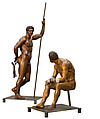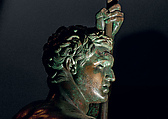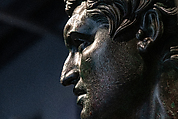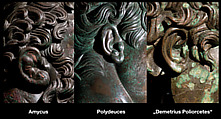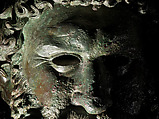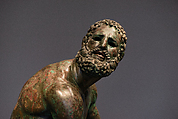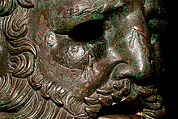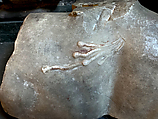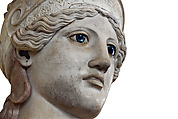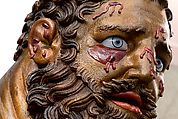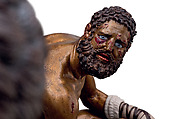Returned to lender The Met accepts temporary loans of art both for short-term exhibitions and for long-term display in its galleries.
Reconstruction of the bronze statue from the Quirinal in Rome of the so-called Terme Ruler
Vinzenz Brinkmann German
Ulrike Koch-Brinkmann
Not on view
The two original Greek bronze statues reconstructed here were discovered on the Quirinal Hill of Rome in 1885 near the ancient Baths of Constantine and are now on display in the Palazzo Massimo alle Terme in Rome.
Visual and scientific analyses of the original sculptures have revealed extensive surface treatments and applied color. The standing figure leans on a spear in a heroic pose, while the boxer sits with his arms resting on his knees, head turned to the right and slightly raised. The figures’ identification and relationship to one another remains unresolved. One line of interpretation suggests that an important adventure from the Jason and the Argonaut saga is represented: the standing Polydeukes, son of Zeus, has defeated Amykos, son of Poseidon, in a boxing match and now urges him to refrain from murdering strangers with his deadly knuckles. Both statues display the swollen ears of a fighter.
"The famous bronze statues from the Quirinal in Rome were found in 1885 during excavation for a theater. Despite the fact that they were found together, the two bronzes came to be known as the Hellenistic "Ruler" and the victorious "Boxer," and in the archaeological literature they were most often treated separately and identified with a wide variety of historical individuals.
The reconstructions presented here follow an interpretation by an American scholar in the 1940's who, on the basis of an Etruscan mirror, posited that the pair depicts a mythological group, namely, an episode from the story of the Argonauts. In Greek mythology, Polydeukes was the son of Zeus and one of the Dioskouroi (twin half-brothers born to the princess Leda, who became a Spartan queen). Amykos was the king of the Bebrykes, a people who lived in northern Anatolia (modern-day Turkey) According to the story, Polydeukes defeats Amykos who was in the habit of killing all strangers, in a boxing match, which compelled the Berbrykes to show the Argonauts hospitality.
The figure of the boxer displays heavily bleeding wounds on the face and the ears. The blood, fashioned of copper, is mostly well-preserved, and for the reconstruction it has been restored in those areas where it is missing. In the original, a sheet of bronze with a high lead content was applied underneath the right eye to represent a hematoma. For the reconstruction, this black eye was cast using a comparable alloy, which, together with an artificial patination, resulted in a dark shade of violet. The swollen lips and the nipples were formed separately in copper, and this was imitated for the reconstruction. Garnets were inserted in the larger wounds in order to reproduce the gleaming effect and the density of fresh blood. Both reconstructed statues were artificially patinated and, following an ancient technique, covered with an asphalt lacquer. The eyes were fashioned from polished precious stones, for which there is evidence among surviving bronze statues, and leather straps for binding boxing gloves were added, held in the right hand of the so-called ruler.
The Greek poet Theocritus describes the unequal struggle in a poem about the Dioskouroi Castor and Polydeukes (Pollux in Roman mythology) around 270 BC. The youthful hero Polydeukes dodges the deadly blows of King Amykos and seriously injures him. Polydeukes knocks out the older man's rows of teeth and inflicts heavily bleeding lacerations on his forehead and temples and a severely swelling hematoma under his right eye. Questions remain regarding whether the bronze group repeats the scene described by the poet or whether Theocritus was inspired by the sight of the two sculptures."
Vinzenz Brinkmann and Ulrike Koch-Brinkmann
Reconstruction 2018:
Vinzenz Brinkmann and Ulrike Koch-Brinkmann
bronze, copper, colored stones, asphalt, linseed oil, madder lake, indigo
H. 241 cm.
3-D printing in PMMA and wax: Alexandra Bongartz (scan), Ralf Deuke, Creabis (data processing), voxeljet (printing); bronze casting: Strassacker Co., Süssen; engraving: Karlheinz Fröstel, Philipp Gorges; patination (liver of sulphur): Recep Sari; inlays of lead bronze and copper: Kristina Balzer, Ulrike Dyri; stone carving: Mirco Galle, Groh + Ripp, Tobias Leyser; asphalt lacquer with linseed oil, madder, lake, indigo: Ulrike Koch-Brinkmann
Liebieghaus Skulpturensammlung (Liebieghaus Polychromy Research Project), Frankfurt am Main, inv. St.P 722, St.P 723
Scientific methods employed:
Digital microscopy (Olimpia Colacicchi Alessandri, Servizio e Laboratorio di Ristauro)
Thermographic measurements (Fulvio Mercuri, Dipartimento di Ingegneria Industriale, Università degli Studi di Roma "Tor Vergata")
X-ray fluorescence spectroscopy (XRF) (Marco Ferretti, Consiglio Nazionale delle Ricerche, Istituto per le Technologie Applicate ai Beni Culturali, Ulderico Santamaria, Laboratorio di Diagnostica per la Conservazione e il Restauro, Università degli Studi della Tuscia)
endoscopy (Olympus Italia)
Raking light imaging (Schott KL 1500 and others)
Visible-reflected imaging (VIS)
Cross section of the bronze cast
Scientific evaluation:
Vinzenz Brinkmann, Ulrike Koch-Brinkmann, Heinrich Piening
Acknowledgements:
Salvatore Settis
Oliver Primavesi
Museo Nazionale Romano
Olympus Italy
Sven Becker
Due to rights restrictions, this image cannot be enlarged, viewed at full screen, or downloaded.
This artwork is meant to be viewed from right to left. Scroll left to view more.
